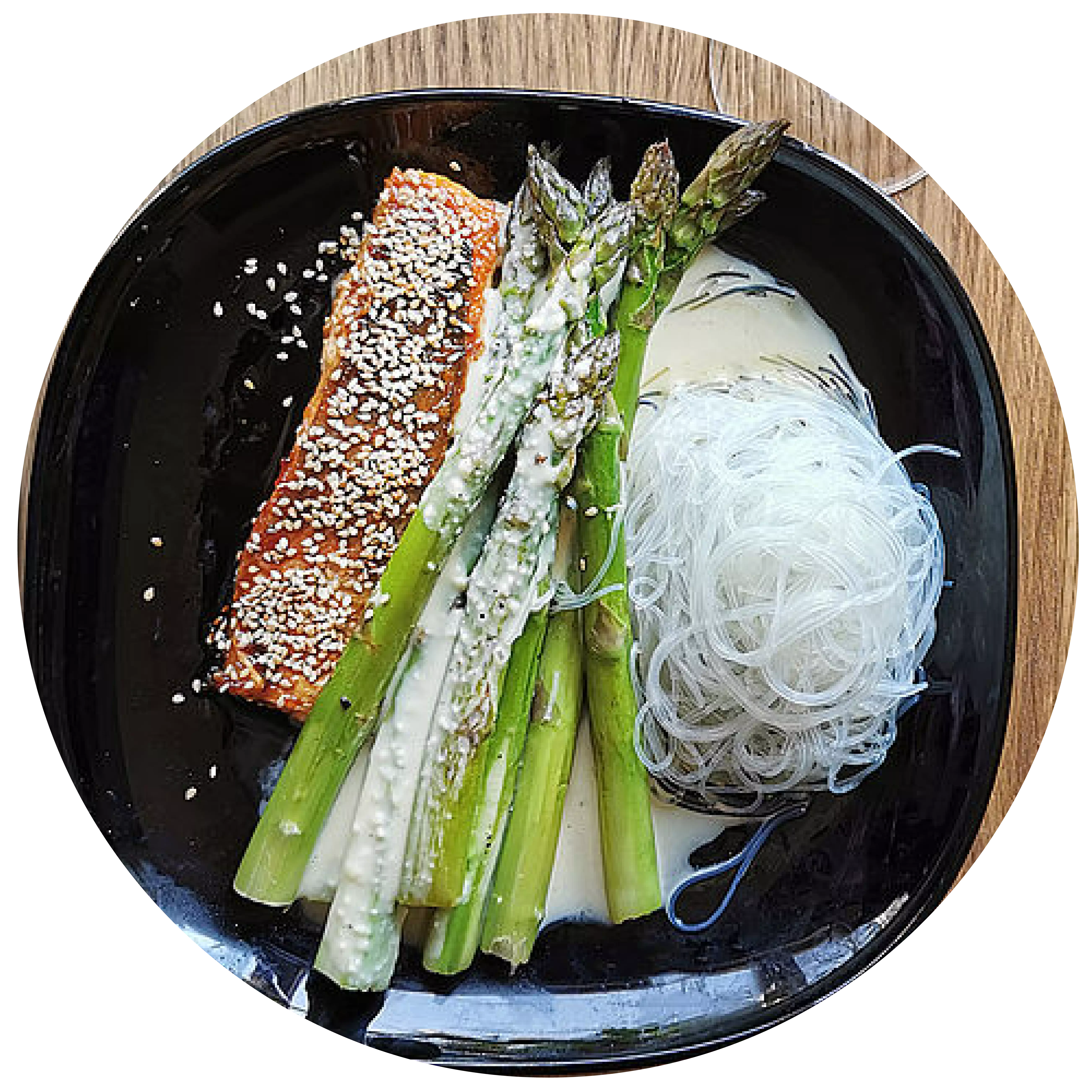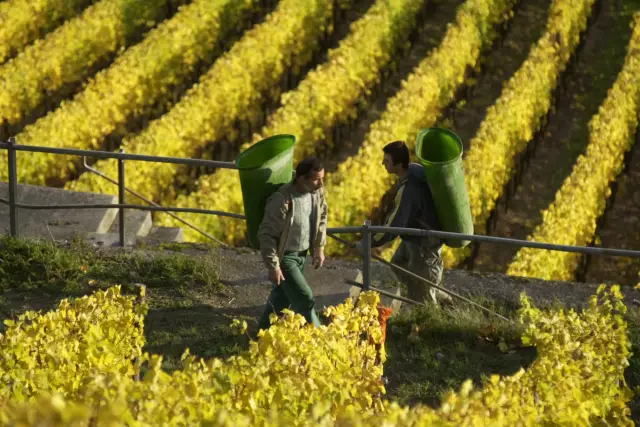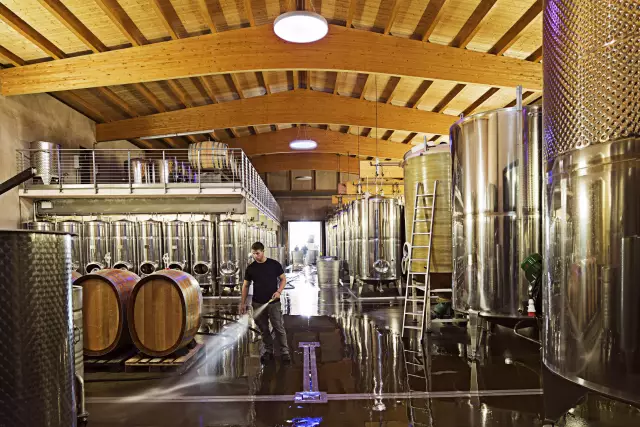Climate & Weather
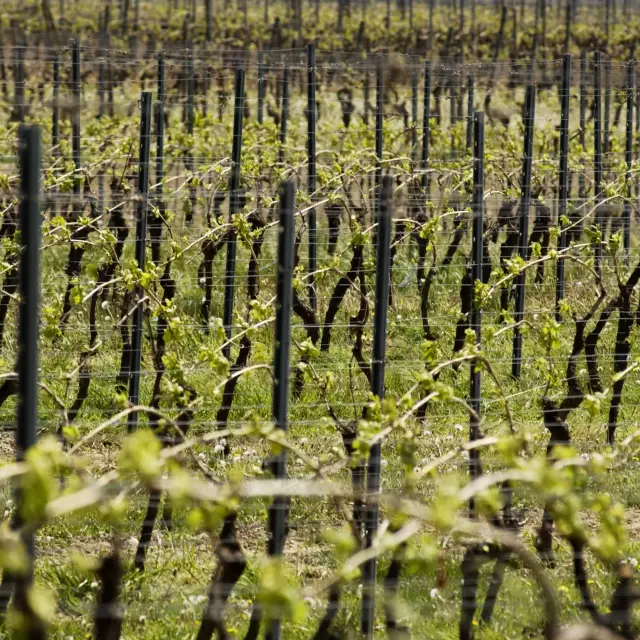
Warm temperatures in the spring increasingly provide early budding. Then night frosts can be dangerous for the young shoots.
Facts
-
1.300 h
of sunshine
-
15 °
average temperature
-
400-500 mm
precipitation
Climate and Weather
Climatic requirements for grape-growing
In terms of climate, the minimum requirements include:
- 1,300 hours of sunshine annually
- an average temperature of at least 15°C (59°F) during flowering and
- 18°C (64°F) during vegetation
- annual precipitation of at least 400-500 ml per square meter.
Germany's climate
The bulk of precipitation in Germany occurs in the summer, while in the southern wine-growing countries, it rains primarily in the spring, autumn and winter. Here, rainfall generally decreases during the final stage of ripening; in the south, rainfall increases dramatically as the harvest approaches. These climatic factors have a pronounced influence on German wine.
Moderately warm summers, favorable amounts of precipitation during vegetation and the long ripening period enable the grapes to develop and retain their fruity acidity - the hallmark of German wines, particularly the whites. In Germany, the quantity and quality of each vintage depends considerably on weather conditions, a factor that plays much less of a role further south.
Challenges of climate change
Climate change presents German winegrowers with new challenges every year as weather conditions become more unpredictable and extreme.
For example, in 2020 only one winemaker harvested ice wine due to the overly mild climate, and bud burst and flowering is starting earlier than ever before.
Overall, however, German winegrowers here at the northern edge of the winegrowing world benefit from the increased average temperatures of recent years, so long as overly dry summers do not occur regularly.
The danger of late-ripening grape varieties not reaching optimal ripeness has long ceased. With their traditional grape varieties, German producers are still well positioned for the near future.
Frost risk and possible measures to counteract this
Warm temperatures in spring ensure that the vines shoot early but then night frosts become a danger for these young shoots. Starting at -1 ° C, it can become critical for the vine. Winemakers use small wind turbines, fan heaters, frost candles or even helicopters, to try to push the frost out of the rows of vines:
- Small stationary wind turbines, about 20 meters high, swirl the air so that warmer and colder layers mix and prevent ground frost. However, the investment costs are high: With a wind turbine costing around 30,000 euros, around five hectares of vineyards can be protected from frost.
- The same effect over larger areas can be achieved with the use of helicopters. However, in many cases they are only allowed to fly from dawn and this is extremely expensive.
- Frost candles can help on smaller areas: These are small metal drums that burn paraffin, creating a pull in the vineyard and thus circulating the air. However, hundreds of such candles must be placed per hectare to achieve the desired effect.
- Fruit growers often try to protect their cherry, apple and pear trees with fan heaters or a so-called frost sprinkler.
- Valerian preparations against frost are applied in biodynamic cultivation. Even though it is still largely unclear scientifically why and how valerian raises the ambient temperature by up to 2 ° C, winegrowers have already had good experiences with it. This can also work to a limited extent if frost damage has already occurred.
Which is the hottest wine-producing city in Germany?
This title is held by Freiburg im Breisgau with an annual average of about 10.5°C, followed by Oppenheim in Rheinhessen.
Varietals

More recipe ideas
with goat's cheese Courgette and chanterelle salad
with goat's cheese
- 2 ganze Zucchini
- 3 EL Rapsöl
- 1 kleine Schalotte
- 300 Gramm Pfifferlinge
- 1 Msp. gemahlener Piment
- 2 Bund Rucola
- je 1/2 Bund Kerbel u. glatte Petersilie
- je 3 EL Walnuss- u. Rapsöl
- 4 Stück Ziegenkäse-Taler
- 1 Prise Zucker
- nach Belieben Salz & Pfeffer
Salad:
Wash the courgettes and slice thinly. Place in a bowl and mix with the oil.
Heat a grill pan and fry the courgettes in batches until golden brown. Season with salt and pepper, place in a bowl.
<p
<p>Peel and finely dice the shallot. Clean the chanterelles, wash if necessary and pat dry. Depending on size, cut in half if necessary.
<p
<p>Sauté the shallot in a pan until translucent. Add the chanterelles and fry vigorously for 3 minutes while stirring. Season with salt, pepper and allspice. Add to the courgettes. Wash the rocket and spin dry.
Dressing:
Wash the herbs, shake dry. Pluck the leaves, blend finely with both types of oil and vinegar in a blender or with a hand blender. Flavour with salt, pepper and sugar. Pour over the courgette and chanterelle mix and mix loosely with the rocket. Arrange on plates, sprinkle with goat's cheese.
- Pinot Blanc (trocken)
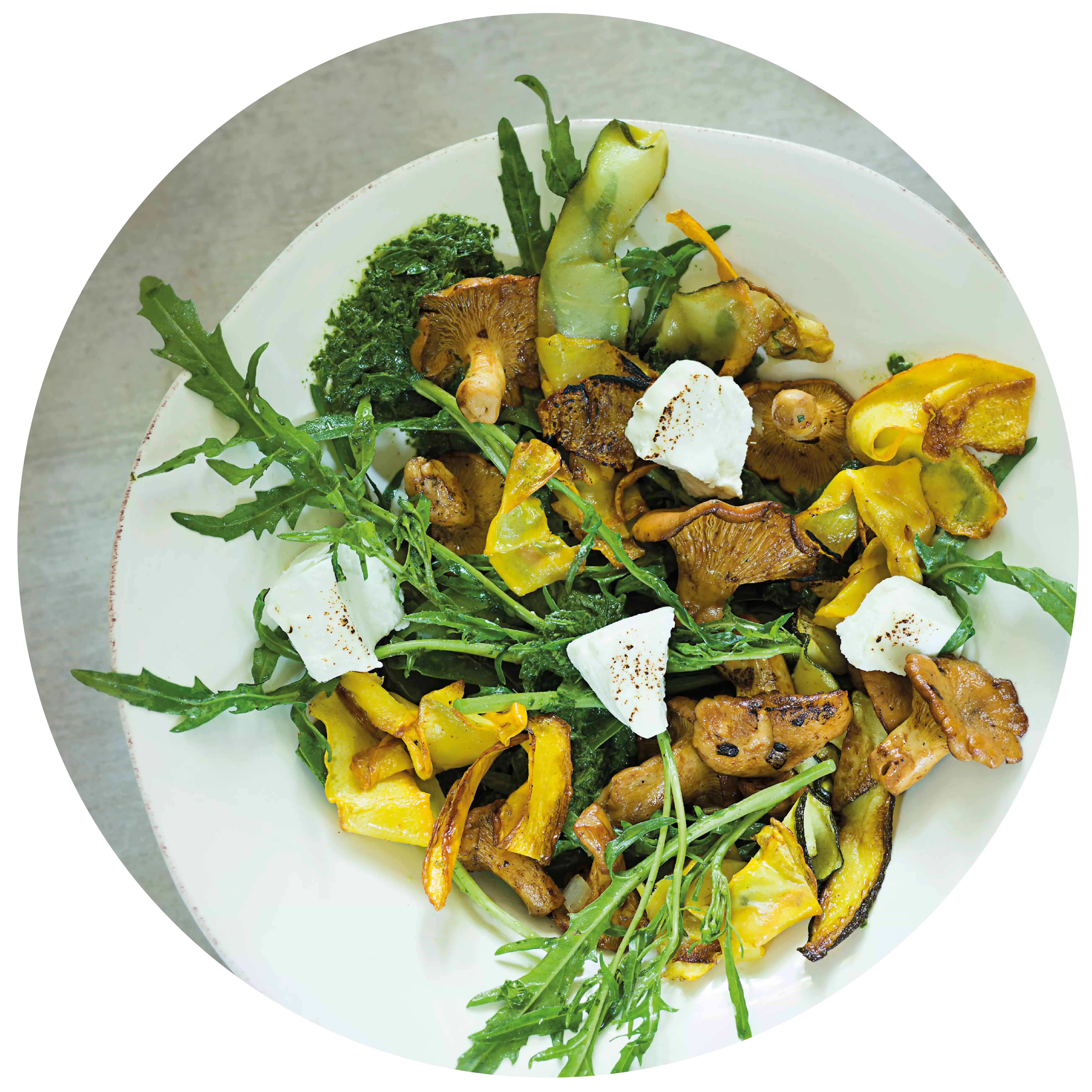
Light and fluffy: cashew coconut mousse with passion fruit Cashew coconut mousse with passion fruit
An airy cashew coconut mousse with passion fruit
- 400g Cashewkerne
- 400ml Haferdrink
- 6EL Agavendicksaft
- 6EL Kokosflocken
- 4 Passionsfrüchte
- 1 Prise Vanille
Place the cashews in a container and add enough water to cover the cashews sufficiently. Place the cashews in the fridge to soak overnight.
(With a high-performance blender, 3-4 hours is also sufficient.)
Drain the water and place the cashews in the blender with the oat milk, agave syrup and coconut flakes. Add the vanilla and blend until the mousse is creamy and no longer contains any chunks.
<p
<p>Divide the mousse between four glasses. Halve the passion fruit, scrape out the flesh with a teaspoon and place on top of the mousse. Decorate with coconut flakes.
- Pinot Blanc (süß & edelsüß)
- Riesling (süß & edelsüß)
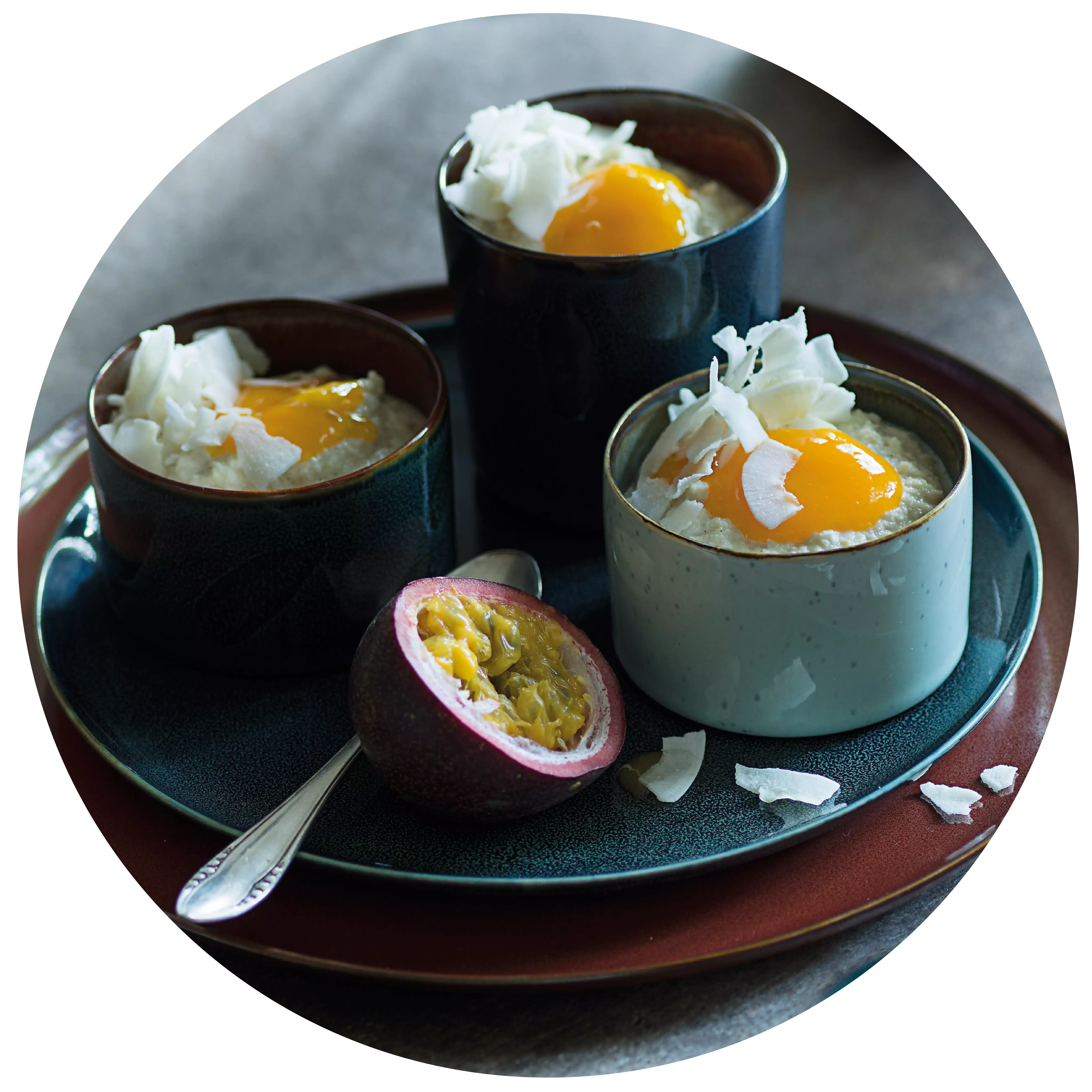
with honey and thyme Goat's cheese tower
with honey and thyme
- 1 großer Apfel
- 1 Rolle Ziegenkäse
- 4 Scheiben Bacon
- 4 TL Honig
- 1 TL Thymian
- 4 Blätter Eichblattsalat
- frische Zweige Thymian zum Garnieren
- nach Belieben Salz & Pfeffer
Preheat the grill to the highest setting.
Fry the bacon slices without fat in a non-stick frying pan until crispy and drain on a piece of kitchen paper. Leave the rendered fat in the pan.
Wash the apple, core it with a corer and then cut it into four, approx. 1 cm thick slices. Slowly fry the apple slices in the remaining bacon fat until just cooked, using the tip of a knife to check the doneness. Place the apple slices in a lightly greased baking dish, sprinkle with thyme and place a crispy fried bacon slice on top of each one.
Divide the goat's cheese into 4 thalers and place one thaler on each apple slice, sprinkle with thyme again and drizzle with 1 teaspoon of honey.
Bake under the grill until the cheese is lightly browned.
Serve the goat's cheese and apple tartlets on a lettuce leaf or, if you prefer, on a bed of lettuce (add a honey-flavoured dressing)
- Dornfelder (halbtrocken & feinherb)
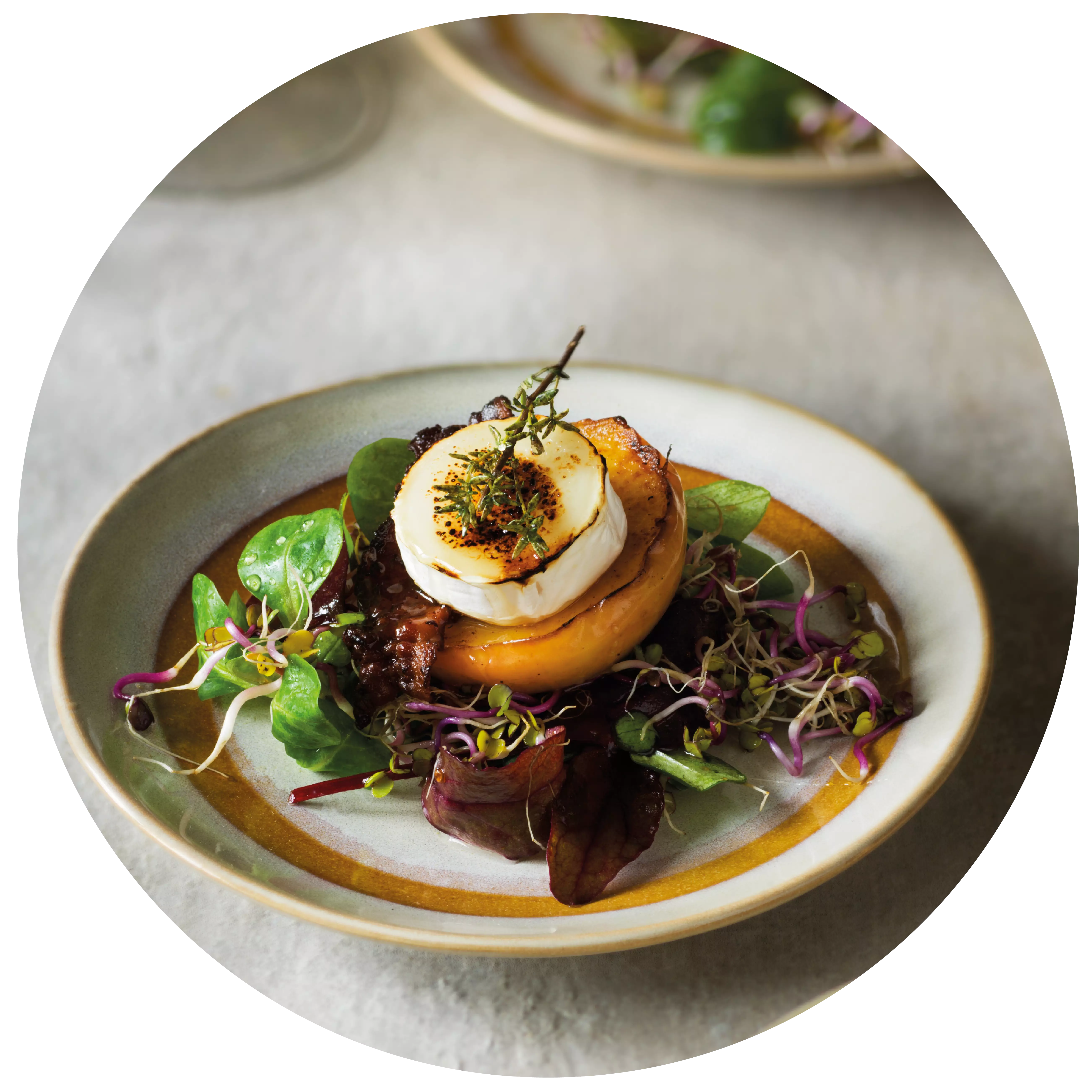
Japanese hollandaise succeeds with wasabi paste Salmon with Japanese hollandaise and green asparagus
Combine salmon with hollandaise and asparagus with a dry Riesling.
- 4x 150g Lachsfilet mit Haut
- 1 Limette
- 2 Zehen Knoblauch
- 4 EL Honig
- 10 EL Sojasauce
- 200g Butter
- 4 Eier
- 1 EL Joghurt
- 2 EL Reisessig
- 2 EL Wasabipaste
- 500 g Grüner Spargel
For the marinade, finely chop the garlic first. Wash the lime in hot water, grate the zest and squeeze out the juice and bring everything to the boil with the honey and soya sauce. Put to one side.
Now prepare the Japanese hollandaise: Bring 180g butter to the boil. Place the egg yolks, yoghurt, rice vinegar, wasabi paste and a pinch of salt in a tall measuring jug and mix with a hand blender. Gradually mix the boiling (!) butter into the egg yolks using a hand blender. Season the hollandaise with salt and pepper to taste and keep the measuring jug warm in hot water.
Peel the bottom third of 500 g green asparagus and cut off the ends. Melt 1 tbsp butter in a large pan. Add the asparagus to the pan, pour in 50 ml water and season with salt and pepper. Cover and bring to the boil briefly.
Fry the salmon fillets on the skin side in a little oil for about 4 minutes. Turn the salmon and fry for a further 2 minutes. Then turn again and baste with the marinade. Remove the salmon from the pan and reduce the marinade until thick. Brush the salmon with it. Serve the salmon with the hollandaise and asparagus. Enjoy your meal!
Wine recommendation:
WINE TIP: Dry Rielsing
- Riesling (trocken)
